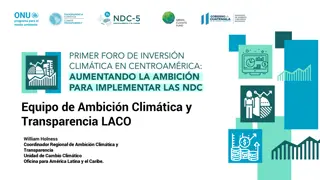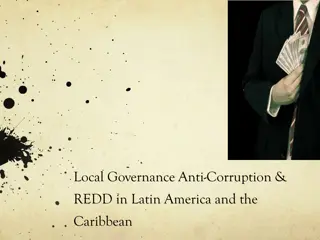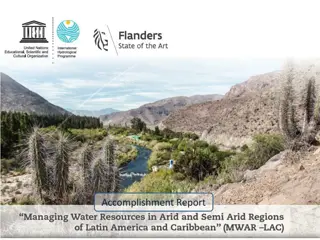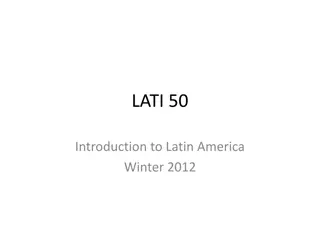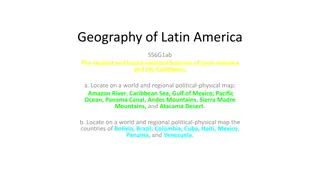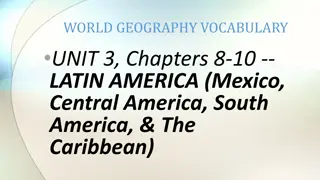Challenges of Industrial Development in Latin America and the Caribbean
The long-term challenges of industrial development in Latin America and the Caribbean present structural problems, including productivity, competitiveness, and wages. There is a need for strategic design and sustainability to address current issues and drive growth in the region towards a more inclusive and productive future.
Download Presentation

Please find below an Image/Link to download the presentation.
The content on the website is provided AS IS for your information and personal use only. It may not be sold, licensed, or shared on other websites without obtaining consent from the author.If you encounter any issues during the download, it is possible that the publisher has removed the file from their server.
You are allowed to download the files provided on this website for personal or commercial use, subject to the condition that they are used lawfully. All files are the property of their respective owners.
The content on the website is provided AS IS for your information and personal use only. It may not be sold, licensed, or shared on other websites without obtaining consent from the author.
E N D
Presentation Transcript
Long-term challenges of industrial development in Latin America and the Caribbean Is there a successful contemporary development experience that has not been based on the manufacturing sector and has not been driven by deliberate policies? Jorge M ttar Bologna, Italy, 19-20 Octobre 2017 .
1. Policy and long term industrial development in LAC: one model, three styles South America commodities, manufacturing based on natural resources with little industrial transformation, trade focuses in Asia and Europe; Northern Region of LAC - basic manufacturing, maquila , USA main trade partner and investor; Caribbean, financial services and tourism Regional integration - weak trade & investment linkages within the region
and similar results for the whole region Structural heterogeneity: productivity, competitiveness, wages, territorial (between and within countries) Slow incorporation of technical progress: low effort in STI => few new knowledge-intensive dynamic activities Non-competitive and vulnerable international insertion Scheme conducts to economic concentration (income and territorial), regional disparities and social inequality Structural problems persist and new challenges arise, such as the impact of robotisation on employment
Productivity is lagging within the region and with respect to world
2. Industrial development requires thinking and acting for the long term (regardless of the model or style of development that follows LAC) Sustainable and inclusive development requires long-term strategic design (industrial policy) Complex int l scenario and 2030 Agenda for SD => great opportunity to explore alternatives to the path and style of dev ment and engines of growth followed by the region => Structural transformations, crucial to a) raise investment; b) systematically and permanently raise productivity; (c) revitalize regional integration & cooperation. Strategic thinking and political will are crucial
3. Progressive structural change: the major challenge? Washington consensus exhausted Progressive Structural Change (PSCh): Change in product composition towards dynamic-high productivity activities, incorporating technical progress Increase productivity in existing activities Reduce territorial disparities PSCh brings about higher long-term economic growth and better-paid jobs a new path to inclusive development and reduced inequality and poverty
Income disparities at the territorial level Coeficiente de Gini Ajustado de Desigualdades Territoriales 2000 - 2013 0.60 0.50 0.40 Gini Territorial 0.30 0.20 0.10 Argentina Bolivia Brasil Chile Colombia M xico Per Panam Ecuador Uruguay 0.00 2000 2001 2002 2003 2004 2005 2006 2007 2008 2009 2010 2011 2012 2013 Fuente: CEPAL 2014 en base a informaci n oficial de los pa ses.
a) Challenges for Industry agents 1. Startegic-long term vision to raise productivity 2. Reduce structural heterogeneity (size, activity and territorial disparities) 3. Create and develop new sectors-dynamic, knowledge and tec-intensives 4. Manufacturing sector - growth engine 5. Impact of 4th industrial revolution: e.g. robotisation of employment
b) Challenges for industrial policy 1. Agreement State-Market-Society of an industrial development strategy (attainable objectives, targets, time-table, responsibilities, accountability) 2. Explicit consideration of implementing institutions 3. Training programs to increase the amount and quality of human resources 4. Strengthen linkages policy design implementation 5. Better policy evaluation to improve design, focus and implementation
4. Conclusion: key issues for an industrial policy to face the challenge of structural change 1. Selection of "winners" 2. Available instruments 3. Size limitation of markets 4. Margin of action left by trade policy 5. Political will and management failures
Thank you! @jorgemattaruno jorgemattar1953@gmail.com Whatsapp +5215560760659



